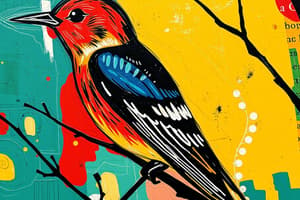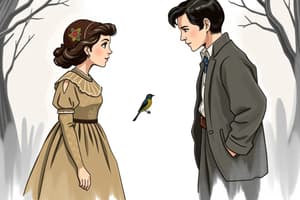Podcast
Questions and Answers
What does the quote 'You never really understand a person until you consider things from his point of view' primarily teach?
What does the quote 'You never really understand a person until you consider things from his point of view' primarily teach?
- The value of historical context
- The importance of perspective-taking and empathy (correct)
- The significance of personal judgment
- The necessity of social conformity
Tom Robinson's wrongful conviction is a representation of the hope present in Maycomb's justice system.
Tom Robinson's wrongful conviction is a representation of the hope present in Maycomb's justice system.
False (B)
What role does Atticus Finch play in the novel?
What role does Atticus Finch play in the novel?
He serves as a moral guide and represents the struggle for justice.
Scout's character development is influenced by _____ and her experiences with racism.
Scout's character development is influenced by _____ and her experiences with racism.
Match the following characters with their influences on Scout:
Match the following characters with their influences on Scout:
What is highlighted by the statement 'Cheating a colored man is 10 times worse than cheating a white man'?
What is highlighted by the statement 'Cheating a colored man is 10 times worse than cheating a white man'?
The lynch mob scene illustrates the positive aspects of collective action.
The lynch mob scene illustrates the positive aspects of collective action.
How does Scout's innocent intervention impact the lynch mob?
How does Scout's innocent intervention impact the lynch mob?
What does Atticus believe is necessary before forming an opinion about others?
What does Atticus believe is necessary before forming an opinion about others?
Scout believes there is only one kind of people.
Scout believes there is only one kind of people.
Which character significantly influences Jem and Scout's understanding of moral courage?
Which character significantly influences Jem and Scout's understanding of moral courage?
What event leads to Boo Radley intervening and saving Scout and Jem?
What event leads to Boo Radley intervening and saving Scout and Jem?
Scout learns to control her temper when faced with prejudice.
Scout learns to control her temper when faced with prejudice.
In Chapter 20, Atticus states, 'In our courts, all men are created ____.'
In Chapter 20, Atticus states, 'In our courts, all men are created ____.'
What lesson does Atticus hope to impart to Jem and Scout regarding the use of guns?
What lesson does Atticus hope to impart to Jem and Scout regarding the use of guns?
Calpurnia exposes Jem and Scout to the difficulties faced by African Americans in Maycomb due to ___ prejudice.
Calpurnia exposes Jem and Scout to the difficulties faced by African Americans in Maycomb due to ___ prejudice.
Match the quotes to their themes:
Match the quotes to their themes:
Match the characters with the lessons they teach Jem and Scout:
Match the characters with the lessons they teach Jem and Scout:
Which theme is primarily highlighted by Scout's understanding of humanity?
Which theme is primarily highlighted by Scout's understanding of humanity?
What event signifies the loss of innocence for Jem and Scout?
What event signifies the loss of innocence for Jem and Scout?
Atticus's approach to justice is based on hearing only one side of the story.
Atticus's approach to justice is based on hearing only one side of the story.
Boo Radley teaches Jem and Scout to judge people based on their actions and not hearsay.
Boo Radley teaches Jem and Scout to judge people based on their actions and not hearsay.
What does Jem begin to understand about Boo Radley?
What does Jem begin to understand about Boo Radley?
How does Atticus demonstrate true strength in the novel?
How does Atticus demonstrate true strength in the novel?
Flashcards
Empathy in To Kill a Mockingbird
Empathy in To Kill a Mockingbird
Atticus Finch demonstrates empathy by understanding situations from the perspective of others, a key theme in the novel.
Mob Mentality's Danger
Mob Mentality's Danger
Mob mentality can influence people toward harmful actions, as seen in the lynch mob intent on harming Tom Robinson.
Systemic Racism's Horror
Systemic Racism's Horror
Tom Robinson's wrongful conviction highlights the deep-rooted prejudice and injustice faced by African Americans.
Atticus's Moral Courage
Atticus's Moral Courage
Signup and view all the flashcards
Hope Vs. Horror in Mockingbird
Hope Vs. Horror in Mockingbird
Signup and view all the flashcards
Scout's Development
Scout's Development
Signup and view all the flashcards
Moral Lessons in Mockingbird
Moral Lessons in Mockingbird
Signup and view all the flashcards
Social Commentary in Mockingbird
Social Commentary in Mockingbird
Signup and view all the flashcards
Atticus's Justice Approach
Atticus's Justice Approach
Signup and view all the flashcards
Equality in Court?
Equality in Court?
Signup and view all the flashcards
Empathy's Power
Empathy's Power
Signup and view all the flashcards
One Kind of Folks?
One Kind of Folks?
Signup and view all the flashcards
Complexities of Society
Complexities of Society
Signup and view all the flashcards
Boo's Isolation
Boo's Isolation
Signup and view all the flashcards
Town's Code of Conduct
Town's Code of Conduct
Signup and view all the flashcards
Interconnected Themes
Interconnected Themes
Signup and view all the flashcards
Atticus's Lesson
Atticus's Lesson
Signup and view all the flashcards
Atticus's Example
Atticus's Example
Signup and view all the flashcards
Calpurnia's Perspective
Calpurnia's Perspective
Signup and view all the flashcards
Boo Radley: Prejudice's Dangers
Boo Radley: Prejudice's Dangers
Signup and view all the flashcards
Moral Growth
Moral Growth
Signup and view all the flashcards
Mockingbird Symbolism
Mockingbird Symbolism
Signup and view all the flashcards
Prejudice's Impact
Prejudice's Impact
Signup and view all the flashcards
Justice and Injustice
Justice and Injustice
Signup and view all the flashcards
Study Notes
Overview of To Kill a Mockingbird
- The novel is set in the fictional town of Maycomb, Alabama during the Great Depression (1930s)
- The narrative addresses the injustice in society and the importance of moral education.
- The novel explores the themes of racism, injustice, and moral growth.
- Themes of innocence, courage, education, empathy, and the importance of moral nature of human beings are also present
Characters
- Scout Finch: The narrator and protagonist of the novel.
- Jem Finch: Scout's older brother and a key character who embodies the theme of moral education in the book.
- Atticus Finch: Scout and Jem's father. A highly respected lawyer and the moral backbone of Maycomb who strongly values justice, equality, and empathy.
- Boo Radley: An elusive, almost mythic character, is misunderstood and seen as a figure of fear by the children, but possesses inherent goodness.
- Tom Robinson: A black man unjustly accused of raping a white woman; his case is central to the novel, highlighting the injustices of the legal system
- Mayella Ewell: The accuser in the Tom Robinson case, and her character embodies the intersection of race, class, and gender in the novel.
- Bob Ewell: Mayella's abusive father, embodies the destructive force of ignorance and hatred.
Key Themes
- Racism: The novel's central theme, explored through the unjust trial of Tom Robinson and various acts of prejudice in Maycomb.
- Injustice: Social inequality and the biased court system exemplified by Tom Robinson's case.
- Moral Growth: Scout and Jem's transformation from innocence to a greater understanding of the world’s injustices.
- Courage: Atticus Finch's courage to stand up for what's right, despite the overwhelming odds, and the courage of Boo Radley.
- Empathy: Atticus’s teaching the children to consider things from others’ point of view and the importance of walking in someone else’s shoes.
- Education: The novel criticises the formal education system of the day, highlighting the contrast between education in school and moral education from Atticus.
- Loss of Innocence: The harsh realities of society shatter the children’s idealistic view of the world, particularly through the trial of Tom Robinson.
Plot Summary
- The story of Scout and Jem Finch's coming-of-age story
- Details Atticus’s defense of Tom Robinson, which centers on the case
- Highlighting societal divisions and prejudice in Maycomb
- The climax is the trial and conviction of Tom Robinson.
- The novel concludes with Boo Radley's intervention, saving Scout and Jem from Bob Ewell.
Studying That Suits You
Use AI to generate personalized quizzes and flashcards to suit your learning preferences.




